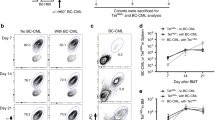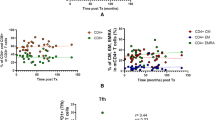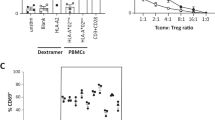Abstract
The alloimmune response against fully MHC-mismatched allografts, compared with immune responses to nominal antigens, entails an unusually large clonal size of alloreactive T cells1. Thus, induction of peripheral allograft tolerance established in the absence of immune system ablation and reconstitution is a challenging task in transplantation. Here, we determined whether a reduction in the mass of alloreactive T cells due to apoptosis is an essential initial step for induction of stable allograft tolerance with non-lymphoablative therapy. Blocking both CD28–B7 and CD40–CD40 ligand interactions (co-stimulation blockade) inhibited proliferation of alloreactive T cells in vivo while allowing cell cycle-dependent T-cell apoptosis of proliferating T cells, with permanent engraftment of cardiac allografts but not skin allografts. Treatment with rapamycin plus co-stimulation blockade resulted in massive apoptosis of alloreactive T cells and produced stable skin allograft tolerance, a very stringent test of allograft tolerance. In contrast, treatment with cyclosporine A and co-stimulation blockade abolished T-cell proliferation and apoptosis, as well as the induction of stable allograft tolerance. Our data indicate that induction of T-cell apoptosis and peripheral allograft tolerance is prevented by blocking both signal 1 and signal 2 of T-cell activation.
This is a preview of subscription content, access via your institution
Access options
Subscribe to this journal
Receive 12 print issues and online access
$209.00 per year
only $17.42 per issue
Buy this article
- Purchase on Springer Link
- Instant access to full article PDF
Prices may be subject to local taxes which are calculated during checkout


Similar content being viewed by others
References
Warrens, A.N., Lombardi, G. & Lechler, R.I. Presentation and recognition of major and minor histocompatibility antigens. Transpl. Immunol. 2, 103– 107 (1994).
Dai, Z., Konieczny, B.T., Baddoura, F.K. & Lakkis, F.G. Impaired alloantigen mediated T-cell apoptosis and failure to induce long term allograft survival in IL-2 deficient mice. J. Immunol. 161, 1659–1663 (1998).
Li, X.C., Zheng, X.X., Zand, M.S., Li, Y. & Strom, T.B. IL-2 dependent rapamycin resistent signals are required for tolerance induction and T-cell apoptosis. Transplantation 65, S169–665 (1998).
Abraham, R.T. & Wiederrecht, G.J. Immunopharmacology of rapamycin. Annu. Rev. Immunol. 14, 483– 510 (1996).
Bierer, B.E. et al. Two distinct signal transmission pathways in T lymphocytes are inhibited by complexes formed between an immunophilin and either FK506 or rapamycin. Proc. Natl. Acad. Sci. USA 87, 9231–9235 (1990).
Ikuta, K., Uchida, N., Friedman, J. & Weissman, I.L. Lymphocyte development from stem cells. Annu. Rev. Immunol. 10 , 759–783 (1992).
Lenschow, D.J. et al. Long term survival of xenogeneic pancreatic islet grafts induced by CTLA-4Ig. Science 257, 789– 792 (1992).
Larsen, C.P. et al. Long term acceptance of skin and cardiac allografts after blocking CD40 and CD28 pathways. Nature 381, 434–438 (1996).
Kirk, A.D. et al. CTLA-4Ig and anti-CD40L prevent renal allograft rejection in primates. Proc. Natl. Acad. Sci. USA 94, 8789–8794 (1997).
Kirk, A.D. et al. Treatment with humanized monoclonal antibody against CD154 prevents acute renal allograft rejection in nonhuman primates. Nature Med. 5, 686–693 ( 1999).
Sykes, M. Chimerism and central tolerance. Curr. Opin. Immunol. 8, 694–703 (1996).
Schreiber, S.L. & Crabtree, G.R. The mechanism of action of cyclosporine A and FK 506. Immunol. Today 13, 136–142 (1992).
Shi, Y.F., Sahai, B.M. & Green, D.R. Cyclosporin A inhibits activation-induced cell death in T-cell hybridomas and thymocytes. Science 339, 625–626 (1989).
Yazdanbakhsh, K., Choi, J. W., Li, Y., Lau, L.F. & Choi, Y. Cyclosporin A blocks apoptosis by inhibiting the DNA binding activity of the transcriptional factor Nur77. Proc. Natl. Acad. Sci. USA 92, 437–441 (1995).
Adachi, M. et al. Interleukin-2 upregulates BAG-1 gene expression through serine-rich region within IL-2 receptor beta chain. Blood 88, 4118–4123 (1996).
Wells, A. D., Gudmundsdottir, H. & Turka, L. A. Following the fate of individual T cells throughout activation and clonal expansion. J. Clin. Invest. 100 , 3173–3183 (1997).
Boise, L. H. et al. CD28 co-stimulation can promote T-cell survival by enhancing the expression of Bcl-XL. Immunity 3, 87 –98 (1995).
Cobbold, S. & Waldmann, H. Infectious tolerance. Curr. Opin. Immunol. 10, 518–524 (1998).
Li, X. C., Zand, M. S., Li, Y., Zheng, X. X. & Strom, T. B. On histocompatibility barriers, Th1 to Th2 immune deviation, and the nature of the allograft responses. J. Immunol. 161, 2241–2247 ( 1998).
Tivol, E.A. et al. CTLA-4Ig prevents lymphoproliferation and fatal multiorgan tissue destruction in CTLA-4 deficient mice. J. Immunol. 158, 5091–5094 (1997).
Larsen, C.P., Morris, P.J. & Austyn, J.M. Migration of dendritic leukocytes from cardiac allografts into host spleens. J. Exp. Med. 171, 307 –314 (1990).
Song, H. K. et al. Alloimmune responses against major and minor histocompatibility antigens: distinct division kinetics and requirement for CD28 co-stimulation. J. Immunol. 162, 2467– 2471 (1999).
Acknowledgements
Grant support for this work was provided by JDF international 1-1999-16 (X.C.L.) and 1-1999-317 (X.X.Z.), National Institutes of Health RO1 AI42298 (T.B.S.), and National Institutes of Health PO AI/GF 41521 (T.B.S. and L.A.T.).
Author information
Authors and Affiliations
Corresponding author
Rights and permissions
About this article
Cite this article
Li, Y., Li, X., Zheng, X. et al. Blocking both signal 1 and signal 2 of T-cell activation prevents apoptosis of alloreactive T cells and induction of peripheral allograft tolerance. Nat Med 5, 1298–1302 (1999). https://doi.org/10.1038/15256
Received:
Accepted:
Issue Date:
DOI: https://doi.org/10.1038/15256
This article is cited by
-
Tolerance Protocols in Large Animal VCA Models—Comprehensive Review
Current Transplantation Reports (2020)
-
T cell co-stimulation and co-inhibition in cardiovascular disease: a double-edged sword
Nature Reviews Cardiology (2019)
-
Coupled feedback regulation of nuclear factor of activated T-cells (NFAT) modulates activation-induced cell death of T cells
Scientific Reports (2019)
-
Comparison of two commonly used methods for stimulating T cells
Biotechnology Letters (2019)



